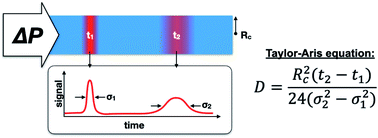Taylor dispersion analysis in fused silica capillaries: a tutorial review
Abstract
Biological and pharmaceutical analytes like liposomes, therapeutic proteins, nanoparticles, and drug-delivery systems are utilized in applications, such as pharmaceutical formulations or biomimetic models, in which controlling their size is often critical. Many of the common techniques for sizing these analytes require method development, significant sample preparation, large sample quantities, and lengthy analysis times. In other cases, such as DLS, sizing can be biased towards the largest constituents in a mixture. Therefore, there is a need for more rapid, sensitive, accurate, and straightforward analytical methods for sizing macromolecules, especially those of biological origin which may be sample-limited. Taylor dispersion analysis (TDA) is a sizing technique that requires no calibration and consumes only nL to pL sample volumes. In TDA, average diffusion coefficients are determined via the Taylor–Aris equation by characterizing band broadening of an analyte plug under well-controlled laminar flow conditions. Diffusion coefficient can then be interpreted as hydrodynamic radius (RH) via the Stokes–Einstein equation. Here, we offer a tutorial review of TDA, intended to make the method better understood and more widely accessible to a community of analytical chemists and separations scientists who may benefit from the unique advantages of this versatile sizing method. We first provide a tutorial on the fundamental principles that allow TDA to achieve calibration-free sizing of analytes across a wide range of RH, with an emphasis on the reduced sample consumption and analysis times that result from utilizing fused silica capillaries. We continue by highlighting relationships between operating parameters and critically important flow conditions. Our discussion continues by looking at methods for applying TDA to sample mixtures via algorithmic approaches and integration of capillary electrophoresis and TDA. Finally, we present a selection of reports that demonstrate TDA applied to complex challenges in bioanalysis and materials science.

- This article is part of the themed collections: Analytical Methods HOT Articles 2021 and Analytical Methods Review Articles 2021


 Please wait while we load your content...
Please wait while we load your content...